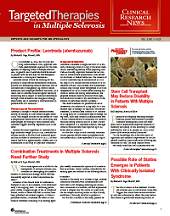Publication
Article
Targeted Therapies: Multiple Sclerosis
Product Profile: Lemtrada (alemtuzumab)
Author(s):
Lemtrada (alemtuzumab) injection is approved for the management of relapsing forms of multiple sclerosis (MS). In general, use of Lemtrada should be limited to patients with MS who have not had therapeutic success with 2 or more prior treatments.

On November 14, 2014, the US Food and Drug Administration (FDA) approved Lemtrada (alemtuzumab) injection for the management of relapsing forms of multiple sclerosis (MS). In general, use of Lemtrada should be limited to patients with MS who have not had therapeutic success with 2 or more prior treatments.1,2
Lemtrada carries a black box warning for the potential to cause serious autoimmune conditions, possibly life-threatening infusion reactions, and an increased risk of malignancy (eg, thyroid cancer, melanoma, and lymphoproliferative disorders). As a result, use of Lemtrada requires regular laboratory monitoring and is subject to restricted distribution through a risk evaluation and mitigation strategy. Importantly, use of Lemtrada is contraindicated in patients with HIV infection.2
Pharmacology and Pharmacokinetics
Lemtrada is thought to reduce immune system activity by binding to a cell surface antigen called CD52. This antigen is found on the surface of T and lymphocytes, natural killer cells, monocytes, and macrophages. By binding to these immune cells, Lemtrada triggers antibody-dependent lysis of the cells.2
Because the active ingredient in Lemtrada has a high molecular weight (150,000 Da), Lemtrada distributes mainly to the blood and interstitial space and has a volume of distribution of 14.1 L. Its elimination half-life is approximately 2 weeks, and it is undetectable in the body 30 days after treatment.2
Dosage and Administration
Lemtrada is available in single-use vials of 1.2 mL, each containing a total of 12 mg of the active medication. Maintaining sterility when preparing Lemtrada is critically important, because the vial contains no antimicrobial preservatives. Vials should not be frozen or shaken before use. The contents of a vial of Lemtrada may be reconstituted in a 100-mL bag of 0.9% sodium chloride solution or of 5% dextrose in water. Once diluted, the reconstituted solution may be kept either refrigerated or at room temperature for up to 8 hours before starting the infusion. Before and during administration, the prepared solution must be protected from light, and should not be used if any discoloration of the solution or particulate matter is present.2
The initial treatment for patients with MS is intravenous (IV) infusion of 12 mg daily for 5 consecutive days of therapy (60 mg total). The second treatment, 12 months later, consists of IV infusion of 12 mg daily for 3 consecutive days of therapy (36 mg total). Each daily infusion is administered over 4 hours. Patients should be monitored for infusion reactions during infusion and for at least 2 hours after completion of a Lemtrada infusion, although infusion reactions have been reported up to 24 hours after an infusion.2
For the first 3 days of each Lemtrada treatment course, patients should receive prophylaxis with corticosteroids at a dose equivalent to 1000 mg of methylprednisolone, and may also receive antihistamines and antipyretics before each infusion. Additionally, patients should receive treatment with an antiviral agent for herpes prophylaxis at least 2 months after the initial course of Lemtrada. Herpes prophylaxis should continue until CD4+ lymphocyte levels recover to a level of 200 cells/μL or higher. As further protection against herpes infection, patients who have not been vaccinated against varicella zoster virus (VZV) should be vaccinated with the live vaccine no less than 6 weeks before starting Lemtrada.2
Monitoring Requirements
Patients should be screened for tuberculosis before initiating treatment. In addition, patients should obtain baseline thyroid function test values, and repeat testing should occur every 3 months. Complete blood count testing (with a differential), serum creatinine levels, and urinalysis with urine cell counts should be conducted at baseline and at monthly intervals during treatment. Because of the risk of melanoma, annual skin examinations are recommended. Women taking Lemtrada should be screened annually for human papilloma virus and cervical dysplasia. If Lemtrada is discontinued, all tests should continue for a minimum of 48 months (4 years) after infusion of the last dose.2
Clinical Studies
Lemtrada has been evaluated in 2 clinical studies of patients with relapsing-remitting MS. The inclusion criteria of both trials included requirements that patients enrolled had to have experienced at least 2 relapses in the 2 years before study entry, and had at least 1 of those relapses in the year before trial enrollment. Investigators performed magnetic resonance imaging (MRI) annually, as well as neurologic examinations every 12 weeks and when suspected relapses occurred.2
Patients enrolled in study 1 were required to have had at least 1 MS relapse while taking either interferon beta or glatiramer acetate, and to have an initial Expanded Disability Status Scale (EDSS) score of 5 or lower. In this open-label study, patients received Lemtrada infusions (n = 426) or interferon beta-1a 44 μg 3 times daily (n = 202) over 2 years. Compared with interferon beta-1a treatment, Lemtrada significantly reduced the annualized relapse rate (0.26/y vs 0.92/y; P <.0001), the proportion of patients with confirmed disability progression after 2 years (13% vs 21%; P = .0084), and the percentage of patients free of MS relapses after 2 years (65% vs 47%; P <.0001). However, the change in T2 lesion volume was not significantly different between the 2 treatments.2,3
Patients enrolled in study 2 were required to have never received a disease-modifying treatment for MS, and to have an initial EDSS score of 3 or lower. In this open-label study, patients received Lemtrada infusions (n = 376) or interferon beta-1a 44 μg 3 times weekly (n = 187) over 2 years. Compared with interferon beta-1a treatment, Lemtrada significantly reduced the annualized relapse rate(0.18/y vs 0.39/y; P <.0001), and the percentage of patients free of MS relapses after 2 years (78% vs 59%; P <.0001). However, the proportion of patients with confirmed disability progression after 2 years and the change in T2 lesion volume were not significantly different between the 2 treatments.2,4
Warnings and Precautions
Lemtrada is a Pregnancy Category C medication. In transgenic mice with human CD52 receptors, use of Lemtrada led to fetal death. Additionally, antithyroid antibodies and other autoantibodies may pass to a fetus through the placenta. Thyroid problems occurring as a result of Lemtrada use may also complicate pregnancy.2
Infusion reactions occurred in 92% of patients receiving Lemtrada in clinical trials, although serious infusion reactions occurred in a small minority (3%) of patients. Infusion reactions may include symptoms such as angioedema, bronchospasm, hypotension, chest pain, bradycardia, tachycardia, transient neurologic symptoms, hypertension, headache, pyrexia, and rash.2
Treatment with Lemtrada may lead to the formation of autoantibodies that can increase the risk of developing autoimmune conditions, including thyroid disorders, immune thrombocytopenia, glomerular nephropathy, autoimmune hemolytic anemia with autoimmune pancytopenia, undifferentiated connective tissue disorders, acquired hemophilia A, rheumatoid arthritis, type 1 diabetes, mellitus, vitiligo, and retinal pigment epitheliopathy.2
Because of its immunosuppressive properties, patients taking Lemtrada are at risk of developing opportunistic infections. Patients using Lemtrada should receive all indicated vaccines before starting therapy, and should not eat unheated food, which may contain Listeria monocytogenes.2
Pneumonitis occurred in 0.5% of patients using Lemtrada in clinical studies. Patients should be aware of the symptoms of pneumonitis, which include shortness of breath, cough, wheezing, chest pain or tightness, and hemoptysis.2
In clinical studies, the most common adverse reactions with Lemtrada were rash, headache, pyrexia, nasopharyngitis, nausea, urinary tract infection, fatigue, insomnia, upper respiratory tract infection, herpes viral infection, urticaria, pruritus, thyroid gland disorders, fungal infection, arthralgia, extremity pain, back pain, diarrhea, sinusitis, oropharyngeal pain, paresthesia, dizziness, abdominal pain, flushing, and vomiting, each of which occurred in at least 10% of patients. For a complete discussion of potential adverse events with Lemtrada, please consult the product package insert.
References
1. Approval establishes Genzyme’s MS franchise in the U.S. with two approved products; follows global approvals. [press release] http://news.genzyme.com/press-release/genzymeslemtrada-approved-fda. Accessed February 2015.
2. Lemtrada (alemtuzumab) [package insert]. Cambridge, MA: Genzyme Corporation; 2014.
3. Coles AJ, Twyman CL, Arnold DL, et al. Alemtuzumab for patients with relapsing multiple sclerosis after disease-modifying therapy: a randomised controlled phase 3 trial. Lancet. 2012;380(9856):1829-1839.
4. Cohen JA, Coles AJ, Arnold DL, et al. Alemtuzumab versus interferon beta 1a as first-line treatment for patients with relapsing-remitting multiple sclerosis: a randomised controlled phase 3 trial. Lancet. 2012;380(9856):1819-1828.






